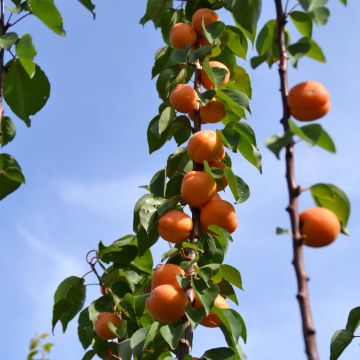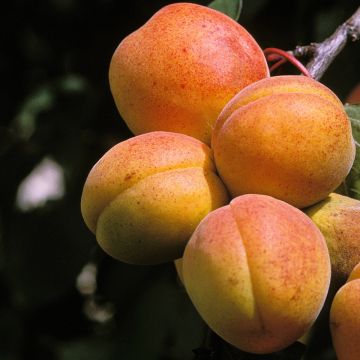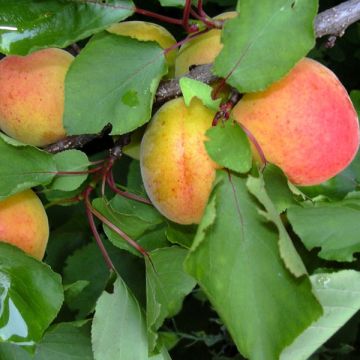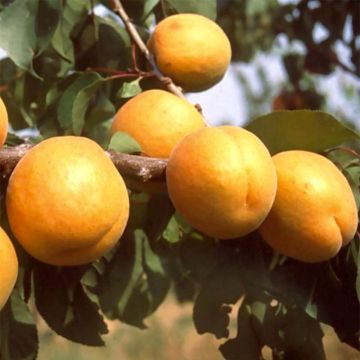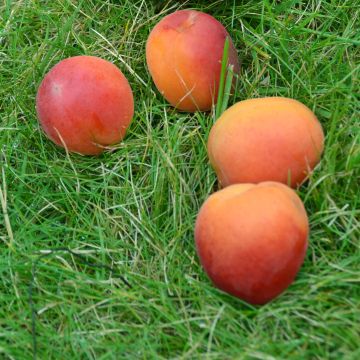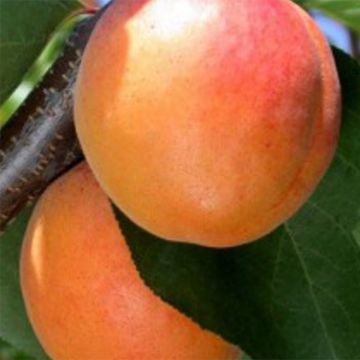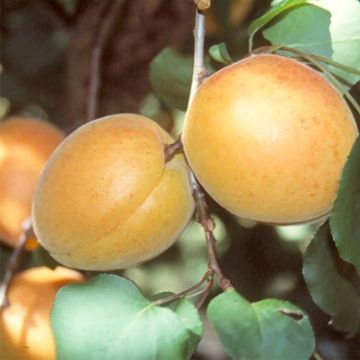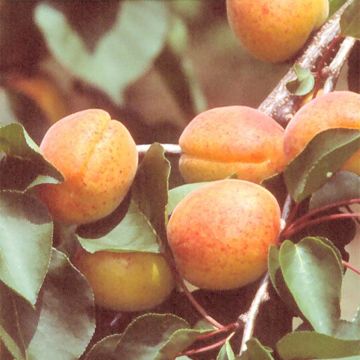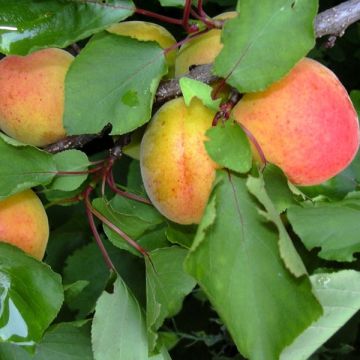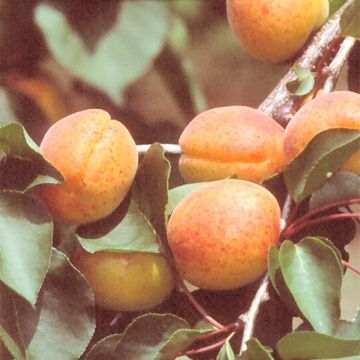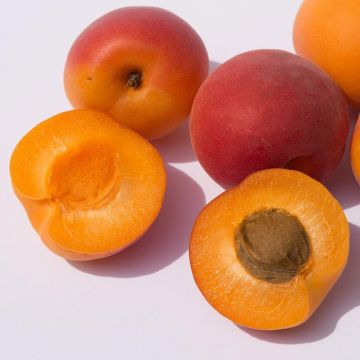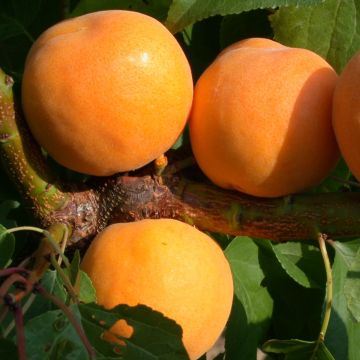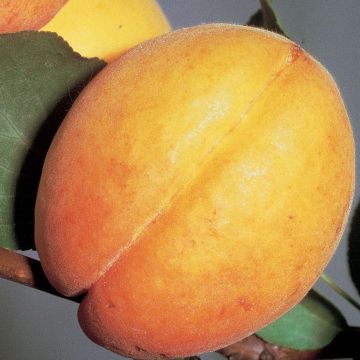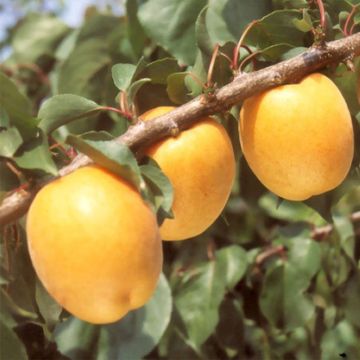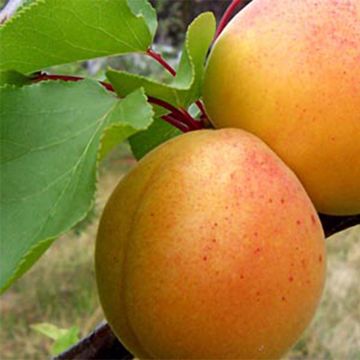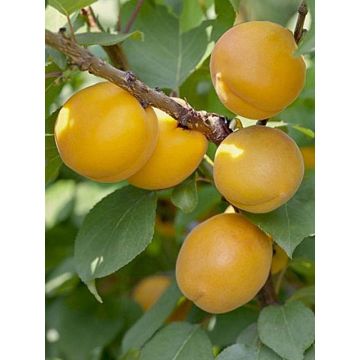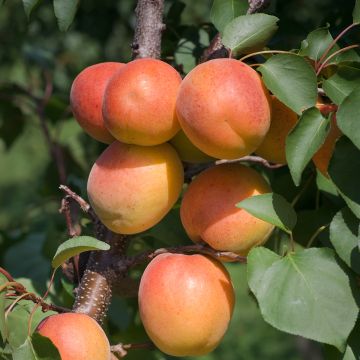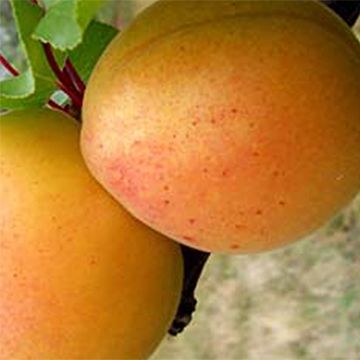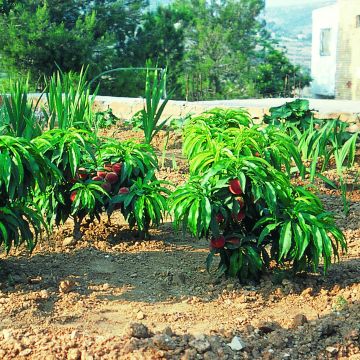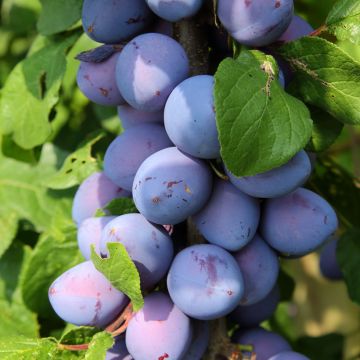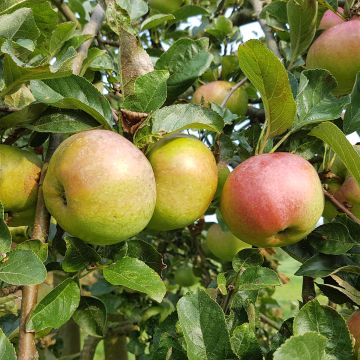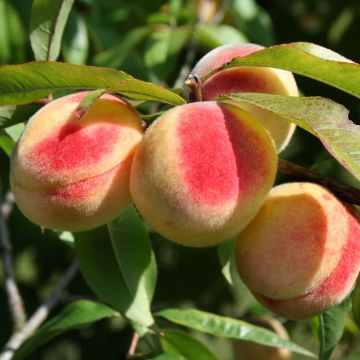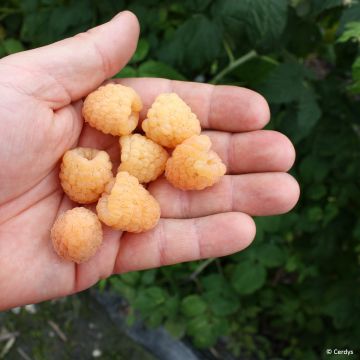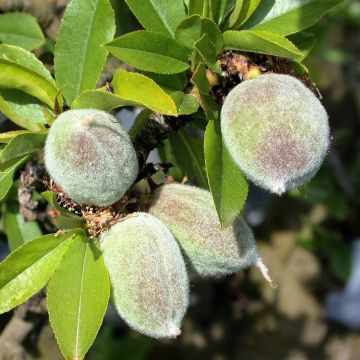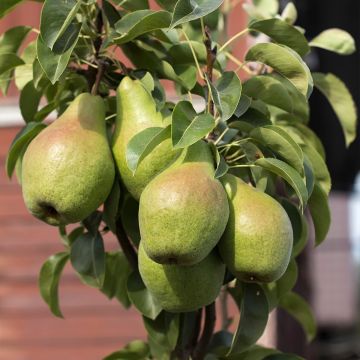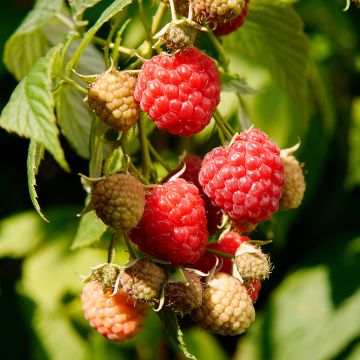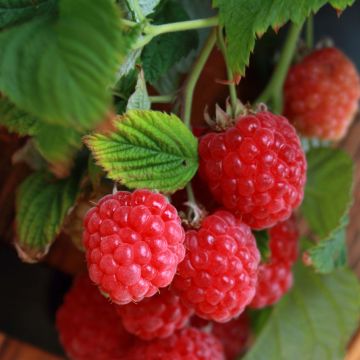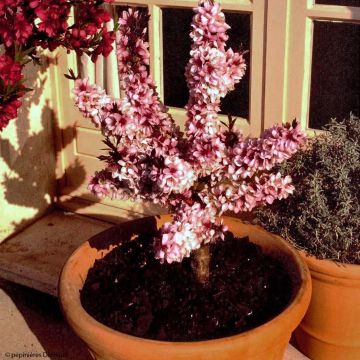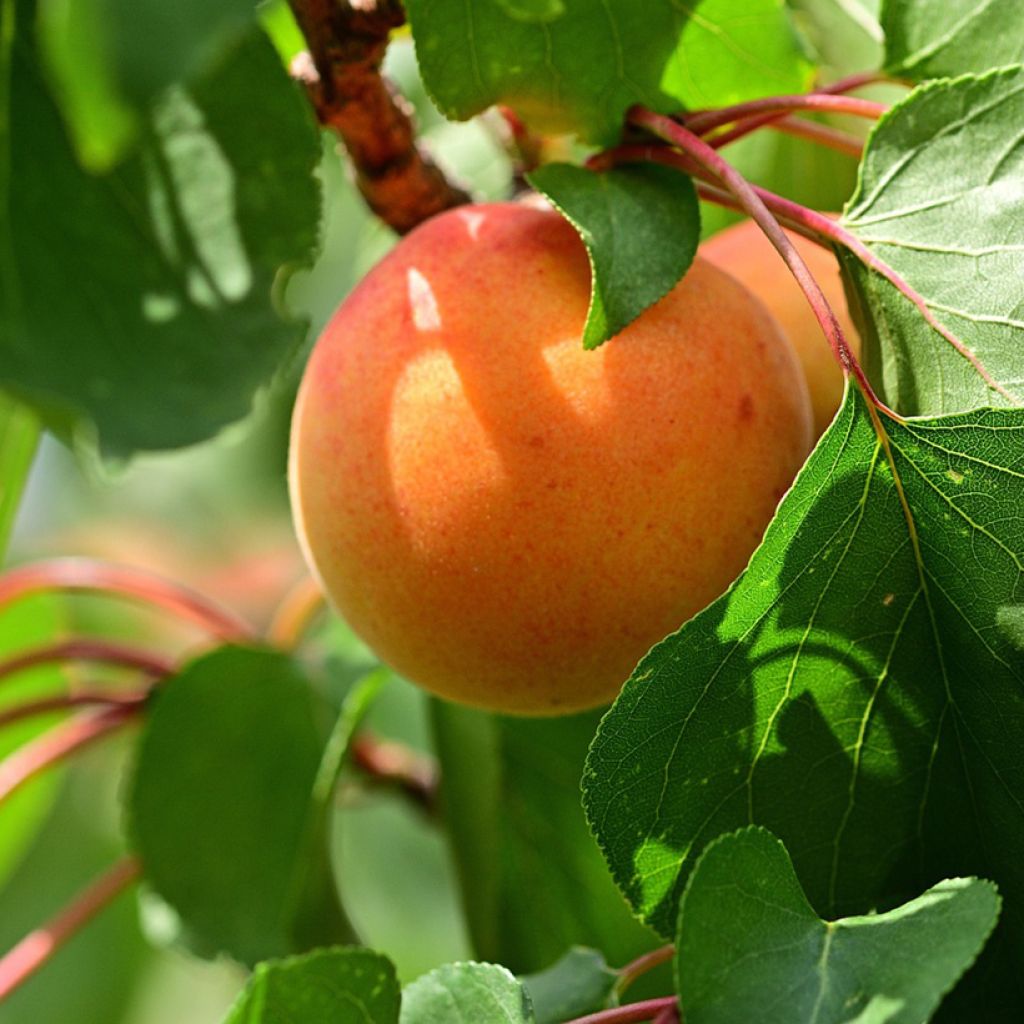

Prunus armeniaca Hungarian Best - Apricot Tree
Prunus armeniaca Hungarian Best - Apricot Tree
Prunus armeniaca Meilleur de Hongrie
Apricot, Armenian plum
Why not try an alternative variety in stock?
View all →This plant carries a 6 months recovery warranty
More information
We guarantee the quality of our plants for a full growing cycle, and will replace at our expense any plant that fails to recover under normal climatic and planting conditions.
Oversize package: home delivery by special carrier from €6.90 per order..
Express home delivery from €8.90.
Delivery to Corse prohibited: UE law prohibits the import of this plant from mainland France to Corse as part of the fight against Xylella fastidiosa. Please accept our sincere apologies.
More information
Description
The Prunus armeniaca 'Hungarian Best' is an old variety known for producing some of the best apricots of all. This small, hardy tree produces fairly large fruits in July, beautifully coloured in orange-red and yellow. Their tender flesh is very aromatic, juicy, and sweet. This apricot tree forms a small tree that will easily find a place in the garden, especially since it is self-fertile and therefore does not require another specimen to ensure pollination. It thrives in most well-drained soils, particularly calcareous ones. A sunny position sheltered from the wind is important for it to thrive.
The Apricot tree is a member of the very important Rosaceae family, which houses most of our temperate climate fruit trees (Apple tree, Plum tree...), many wild plants from the countryside and forests (Burnet, Wild Strawberry...) and countless ornamental plants that populate parks and gardens (Service tree, Aronia, Roses...). The genus Prunus is rich in over 300 species of trees and bushes, whether fruit-bearing or ornamental, or even both at the same time, with many fruit trees, like the Apricot tree, also having decorative blossom. Prunus armeniaca derives its species name from the belief of the Romans that it originated from Armenia. In reality, the species comes from the mountains of Central Asia (from Persia to Manchuria, passing through the Himalayas). Cultivated in China as early as the 3rd millennium BC, and then in Rome.
'Hungarian Best' is an old French variety, obtained in 1920 by Mrs. Bergeron. This apricot tree forms a small tree with an open, slightly spreading habit, reaching 4 to 5 m in height and 3 to 4 m in spread at maturity. The variety is self-fertile, capable of self-pollination in the absence of another tree nearby, which is an advantage (in addition to its compactness) for small gardens. The branches bear leaves of a beautiful bright green, ovate and almost heart-shaped. In March-April, depending on the climate, small, slightly pinkish white flowers of about 2.5 cm in diameter appear. Consequently, the tree is sensitive to late frosts that can destroy any hope of harvest. On the other hand, the tree itself is quite hardy, down to -20°C or even less in very good growing conditions, that is to say, in sunlight and well-drained soil. The medium to large fruits primarily ripen in July, they are pleasant to the eye, with their beautiful yellow-orange colour turning red on the sun-exposed side, and even more so to the taste! Delicious and very aromatic, they offer tender and sweet flesh, with a slight tang that enhances the flavour. These juicy fruits can be eaten fresh or as a dessert, made into delicious tarts or jams that extend the pleasure of tasting until winter. They can also be incorporated into savoury dishes, such as rabbit with apricots and parsnips, an English recipe.
The Apricot tree 'Hungarian Best' will find its place in small gardens and delight fruit enthusiasts. To create a small orchard in a restricted space, plant alongside it a Columnar Cherry 'Shanghai' which does not exceed 60 cm in width, while producing succulent dark red cherries. It is also a self-fertile variety that can stand on its own to bear fruit. To stagger the harvest season, consider the small Dwarf Pear 'Garden Gem', with fruits as large as classic varieties. In September and October, you will harvest beautiful pears with melting and sweet flesh. The small fruits are also a blessing for small gardens; currants, blackcurrants, and raspberries will offer you different and equally delightful flavours.
Report an error about the product description
Prunus armeniaca Hungarian Best - Apricot Tree in pictures
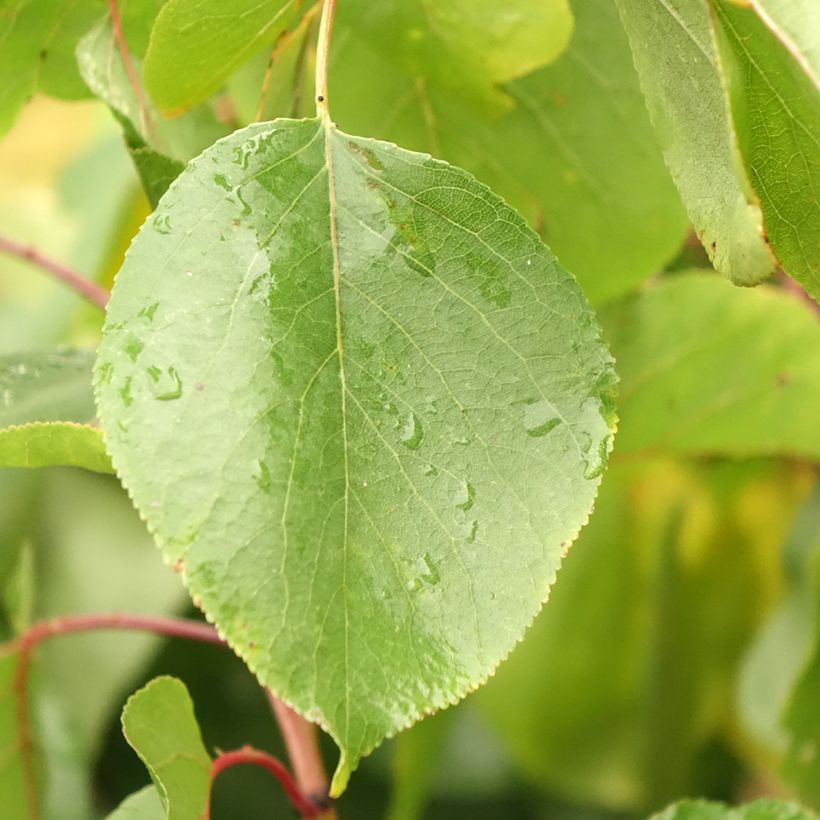

Plant habit
Fruit
Flowering
Foliage
Botanical data
Prunus
armeniaca
Meilleur de Hongrie
Rosaceae
Apricot, Armenian plum
Cultivar or hybrid
Other Apricot trees
Planting and care
Plant the Hungarian Best Apricot Tree at the beginning of winter, when the tree is in a vegetative rest, and before the frosts. To plant several apricot trees, space them at least 1.5 m apart. Dig a hole two to three weeks before planting, twice as wide and deep as the pot. On the day of planting, place the tree with its pot in a bucket of water, so that the entire root ball is moistened. Add compost to the bottom of the hole. Position the tree in the hole, filling in with soil mixed with potting compost. The root ball must be completely covered. Firm it down while watering generously.
The Hungarian Best Apricot Tree is not very demanding regarding the nature of the soil; it adapts well to calcareous and dry soils in summer. It will thrive ideally in rich, light, moist soil, especially well-drained. It does not tolerate very clayey, suffocating, excessively moist soils. Plant it in a sunny position, sheltered from the wind.
Planting period
Intended location
Care
This item has not been reviewed yet - be the first to leave a review about it.
Fruit trees for small gardens
Haven't found what you were looking for?
Hardiness is the lowest winter temperature a plant can endure without suffering serious damage or even dying. However, hardiness is affected by location (a sheltered area, such as a patio), protection (winter cover) and soil type (hardiness is improved by well-drained soil).

Photo Sharing Terms & Conditions
In order to encourage gardeners to interact and share their experiences, Promesse de fleurs offers various media enabling content to be uploaded onto its Site - in particular via the ‘Photo sharing’ module.
The User agrees to refrain from:
- Posting any content that is illegal, prejudicial, insulting, racist, inciteful to hatred, revisionist, contrary to public decency, that infringes on privacy or on the privacy rights of third parties, in particular the publicity rights of persons and goods, intellectual property rights, or the right to privacy.
- Submitting content on behalf of a third party;
- Impersonate the identity of a third party and/or publish any personal information about a third party;
In general, the User undertakes to refrain from any unethical behaviour.
All Content (in particular text, comments, files, images, photos, videos, creative works, etc.), which may be subject to property or intellectual property rights, image or other private rights, shall remain the property of the User, subject to the limited rights granted by the terms of the licence granted by Promesse de fleurs as stated below. Users are at liberty to publish or not to publish such Content on the Site, notably via the ‘Photo Sharing’ facility, and accept that this Content shall be made public and freely accessible, notably on the Internet.
Users further acknowledge, undertake to have ,and guarantee that they hold all necessary rights and permissions to publish such material on the Site, in particular with regard to the legislation in force pertaining to any privacy, property, intellectual property, image, or contractual rights, or rights of any other nature. By publishing such Content on the Site, Users acknowledge accepting full liability as publishers of the Content within the meaning of the law, and grant Promesse de fleurs, free of charge, an inclusive, worldwide licence for the said Content for the entire duration of its publication, including all reproduction, representation, up/downloading, displaying, performing, transmission, and storage rights.
Users also grant permission for their name to be linked to the Content and accept that this link may not always be made available.
By engaging in posting material, Users consent to their Content becoming automatically accessible on the Internet, in particular on other sites and/or blogs and/or web pages of the Promesse de fleurs site, including in particular social pages and the Promesse de fleurs catalogue.
Users may secure the removal of entrusted content free of charge by issuing a simple request via our contact form.
The flowering period indicated on our website applies to countries and regions located in USDA zone 8 (France, the United Kingdom, Ireland, the Netherlands, etc.)
It will vary according to where you live:
- In zones 9 to 10 (Italy, Spain, Greece, etc.), flowering will occur about 2 to 4 weeks earlier.
- In zones 6 to 7 (Germany, Poland, Slovenia, and lower mountainous regions), flowering will be delayed by 2 to 3 weeks.
- In zone 5 (Central Europe, Scandinavia), blooming will be delayed by 3 to 5 weeks.
In temperate climates, pruning of spring-flowering shrubs (forsythia, spireas, etc.) should be done just after flowering.
Pruning of summer-flowering shrubs (Indian Lilac, Perovskia, etc.) can be done in winter or spring.
In cold regions as well as with frost-sensitive plants, avoid pruning too early when severe frosts may still occur.
The planting period indicated on our website applies to countries and regions located in USDA zone 8 (France, United Kingdom, Ireland, Netherlands).
It will vary according to where you live:
- In Mediterranean zones (Marseille, Madrid, Milan, etc.), autumn and winter are the best planting periods.
- In continental zones (Strasbourg, Munich, Vienna, etc.), delay planting by 2 to 3 weeks in spring and bring it forward by 2 to 4 weeks in autumn.
- In mountainous regions (the Alps, Pyrenees, Carpathians, etc.), it is best to plant in late spring (May-June) or late summer (August-September).
The harvesting period indicated on our website applies to countries and regions in USDA zone 8 (France, England, Ireland, the Netherlands).
In colder areas (Scandinavia, Poland, Austria...) fruit and vegetable harvests are likely to be delayed by 3-4 weeks.
In warmer areas (Italy, Spain, Greece, etc.), harvesting will probably take place earlier, depending on weather conditions.
The sowing periods indicated on our website apply to countries and regions within USDA Zone 8 (France, UK, Ireland, Netherlands).
In colder areas (Scandinavia, Poland, Austria...), delay any outdoor sowing by 3-4 weeks, or sow under glass.
In warmer climes (Italy, Spain, Greece, etc.), bring outdoor sowing forward by a few weeks.

































